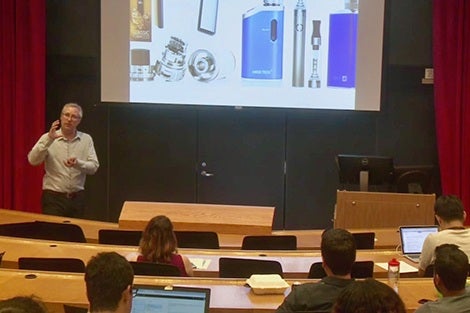July 24, 2018 – Is it wise to steer smokers toward e-cigarettes, in the hope that they offer a safer alternative to traditional cigarettes? Or do e-cigarettes pose too many health risks in their own right?
Vaughan Rees, lecturer on social and behavioral sciences and director of the Center for Global Tobacco Control at Harvard T.H. Chan School of Public Health, discussed the pros and cons of e-cigarettes at a Hot Topics lecture on July 17, 2018.
“New findings suggest that we’re at something of a crossroads in how we approach tobacco control issues,” Rees told an audience in Kresge G2. “But we hope we can use science to guide our way through.”
Rees outlined the enormous health burden posed by tobacco around the globe. In the 20th century, 100 million deaths were attributed to smoking; for the 21st century, 1 billion deaths tobacco-related deaths are predicted. In the U.S. alone, tobacco leads to roughly 480,000 preventable premature deaths each year. The highest smoking rates—and the biggest tobacco-related health burdens—are among poor and marginalized communities, including people with substance abuse problems, mental health issues, or housing instability; members of the LBGTQ community; or those who are in prison.
As smoking rates have declined in the U.S., they’ve gone up in developing nations around the world, where deep-pocketed tobacco companies have aggressively pushed their products, Rees said. marketing has been savvy, promoting the pleasure of smoking, suggesting that certain cigarette brands are safer, and portraying cigarette smoking as aspirational so that it appeals to those who are poor as well as groups such as women, blacks, and youth. Companies have also specifically designed cigarettes to be very addictive, Rees said.
A safer alternative?
E-cigarettes have been touted as a “safe” alternative to smoking because they can deliver aerosolized nicotine that can be inhaled without all the toxins found in regular cigarettes, Rees said. However, e-cigarettes may pose health dangers too—for instance, they may contain toxic heavy metals and formaldehyde.
There’s also concern that e-cigarettes marketed to youth, which can be used with a wide range of fruit and candy-flavored “e-liquids,” will hook kids into nicotine addiction early and possibly lead them toward smoking traditional cigarettes. Rees said that one of the latest versions of e-cigarettes—JUUL, which looks like a USB flash drive—has become very popular among high school students.
Some evidence suggests that e-cigarette use increases young people’s likelihood of smoking regular cigarettes. But Rees said that evidence may be outdated, because recent statistics show that both traditional cigarette smoking and e-cigarette use have declined over the past three years.
Even if e-cigarettes do lead to an uptick in young people smoking regular cigarettes, some researchers say this risk is outweighed by the potentially much larger benefits of reducing smoking worldwide, according to Rees.
For e-cigarettes to deliver on the promise of reducing smoking, they would have to be potent and pleasurable enough to convince smokers to switch for the long term, Rees said. At the same time, it will be important to regulate e-cigarettes to minimize risks to young people—for instance, by making e-cigarette packaging and e-liquid flavors less appealing to kids and by more effectively communicating about potential long-term health impacts.
“We need to communicate intelligently and scientifically accurately the risks and benefits of e-cigarettes,” said Rees.
